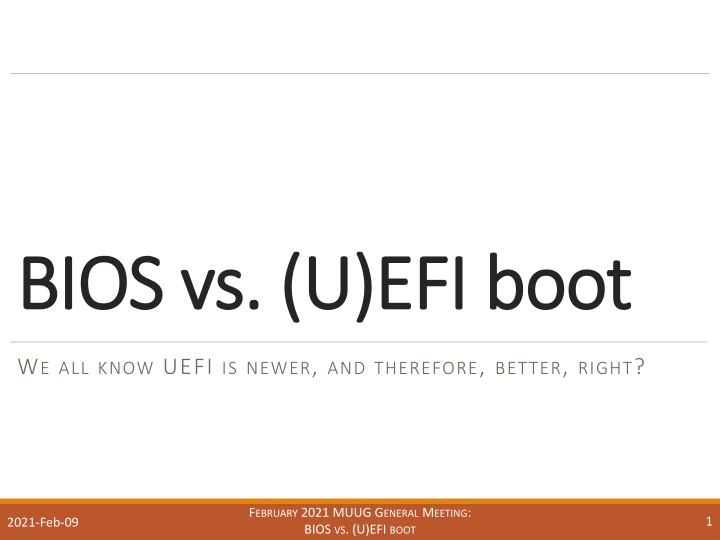
UEFI vs BIOS: Evolution of System Booting
Delve into the history and comparison of BIOS and UEFI boot systems, highlighting their development, functionalities, and impact on computing. Understand the origins, features, and advancements of both technologies in this informative discussion from the February 2021 MUUG General Meeting.
Download Presentation

Please find below an Image/Link to download the presentation.
The content on the website is provided AS IS for your information and personal use only. It may not be sold, licensed, or shared on other websites without obtaining consent from the author. If you encounter any issues during the download, it is possible that the publisher has removed the file from their server.
You are allowed to download the files provided on this website for personal or commercial use, subject to the condition that they are used lawfully. All files are the property of their respective owners.
The content on the website is provided AS IS for your information and personal use only. It may not be sold, licensed, or shared on other websites without obtaining consent from the author.
E N D
Presentation Transcript
BIOS vs. (U)EFI BIOS vs. (U)EFI boot boot WE ALL KNOW UEFI IS NEWER, AND THEREFORE, BETTER, RIGHT? FEBRUARY 2021 MUUG GENERAL MEETING: BIOS VS. (U)EFI BOOT 1 2021-Feb-09
Thanks / Credits Thanks / Credits Thanks to The OpenBSD Project For producing such awesome documentation Intel For open-sourcing part/most of the UEFI specs and implementation, and a little bit of documentation Apple for freaking nothing at all: not following ANY specification, and not even properly documenting what they are doing, either. FEBRUARY 2021 MUUG GENERAL MEETING: BIOS VS. (U)EFI BOOT 2 2021-Feb-09
The contestants The contestants BIOS boot Also including UEFI s CSM (Compatibility Support Module) Boots in real mode, reads a few sectors, executes them Many, many implementations No standard, just do what they did UEFI boot A complete pre-boot environment Multiple implementations One(-ish) official(-ish) standard FEBRUARY 2021 MUUG GENERAL MEETING: BIOS VS. (U)EFI BOOT 3 2021-Feb-09
Abbreviated BIOS history Abbreviated BIOS history BIOS term originates in CP/M circa 1975 Written in assembly by IBM for IBM PC Hard disk support added for IBM PC XT 80286 and 16-bit ISA support added for IBM PC AT First occurrence of CMOS : 50 bytes, battery-backed First occurrence of ATA support Other BIOS clones reverse-engineered during this era, principally by Compaq, Phoenix, and AMI Supports add-in ROMs that extend BIOS functionality More and more features added by many vendors, including network boot & many others FEBRUARY 2021 MUUG GENERAL MEETING: BIOS VS. (U)EFI BOOT 4 2021-Feb-09
Abbreviated UEFI history Abbreviated UEFI history In the beginning, there was darkness then EFI was created for Itanium, and OpenBoot for SPARCs and PowerPC Assembly programming, 16-bit real mode, and pathological coupling to AT hardware made a bunch of people decide that the BIOS sucked now And they said Lo, observe EFI, for it is good and then they messed it all up FEBRUARY 2021 MUUG GENERAL MEETING: BIOS VS. (U)EFI BOOT 5 2021-Feb-09
The first WTF The first WTF UEFI machines are divided into classes: Class 0: Legacy BIOS. As in, no EFI functionality whatsoever Class 1: UEFI in CSM-only mode. Also no EFI functionality whatsoever. And it just gets clearer from there Recap: A Class 0 or 1 UEFI system is a pure BIOS/CSM-only system Or, a Class 0 or 1 UEFI system is not really a UEFI system at all Reminds me of recursive acronyms (e.g. GNU) but backwards UEFI isn t UEFI ? FEBRUARY 2021 MUUG GENERAL MEETING: BIOS VS. (U)EFI BOOT 6 2021-Feb-09
Hang on, whats the CSM? Hang on, what s the CSM? Some UEFI implementations come with a CSM Compatibility Support Module That s backwards compatibility, i.e. BIOS emulation! FEBRUARY 2021 MUUG GENERAL MEETING: BIOS VS. (U)EFI BOOT 7 2021-Feb-09
Comparison Comparison - - 1 1 Function BIOS / UEFI CSM UEFI Hardware initialization Integrated into BIOS; if it s not supported, it doesn t get initialized. Modular approach with drivers , which can (in theory) be added later by the end-user. Bootloader Reads a few sectors from disk at a fixed address and executes them. Then gets out of the way. Loads an entire mini-OS that selects a file, loads it, and executes it. Filesystem support Theoretically infinite, all it cares about are the raw sectors on disk. FAT16/FAT32 only. Other filesystems can theoretically be supported by UEFI drivers. Pre-boot Environment and/or Shell None. Entire miniature OS exists to load bootable images. Arbitrary executable images can be loaded, including a UEFI Shell. Processors / Architectures Re-written in assembler for each CPU/arch. Recompiled from C (usually) for each CPU/arch. FEBRUARY 2021 MUUG GENERAL MEETING: BIOS VS. (U)EFI BOOT 8 2021-Feb-09
Comparison Comparison - - 2 2 Function BIOS / UEFI CSM UEFI Disk sizes Depends on implementation. Currently limited to <2TiB. As long as the EFI partition is within the first 8 ZiB (yes, really), theoretically up to 256 ZiB. Partition table Usually MBR -style for fixed media, no partitions for removable meia. Can be customized. GPT on fixed media, can be customized for removable media. Processor mode Real-mode (16-bit) only. Some experimental versions did really weird $#@! In 32-bit mode. 32-bit protected mode, because it s a real (mini-)OS. Only little-endian CPUs are supported at this time. Accessible memory 1MiB (real-mode) 4GiB (32-bit protected mode) PCI/PCIe address space Inside 1MiB (real-mode), can program high addresses but not access them. Can program and access addresses inside 16EiB (64-bit long mode). FEBRUARY 2021 MUUG GENERAL MEETING: BIOS VS. (U)EFI BOOT 9 2021-Feb-09
Comparison Comparison - - 3 3 Function BIOS / UEFI CSM UEFI Access services from running OS Requires thunking to 16-bit real-mode. Well-defined syscall interface from 32-bit or 64-bit protected modes. Extendability More BIOS code written in assembly, stored in ROM on add-in cards. Device driver compiled to EBC (EFI Byte Code), stored in ROM on add- in cards or stored as files in the EFI Service Partition. Firmware update Proprietary utility only. Fully-supported generic firmware update via UEFI Capsule . Cryptographically- secure booting Zip, zilch, nada. Except by accident, sometimes. (Looking at you, Fujitsu!) Fully defined (and usually supported) with or without a hardware TPM chip. FEBRUARY 2021 MUUG GENERAL MEETING: BIOS VS. (U)EFI BOOT 10 2021-Feb-09
Conclusion (or maybe Concussion) Conclusion (or maybe Concussion) I ve told you a bunch of little white lies, much like your 6th grade science teacher, and for the same reason: Reality is too complicated for a 15-minute presentation. For more details, the rabbit hole into an alternate universe starts here: https://en.wikipedia.org/wiki/BIOS https://en.wikipedia.org/wiki/Unified_Extensible_Firmware_Interface Image credit: Charlie Cottrell, https://xeyeti.com/, https://charliecottrell.com/ FEBRUARY 2021 MUUG GENERAL MEETING: BIOS VS. (U)EFI BOOT 11 2021-Feb-09



















